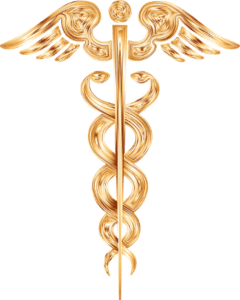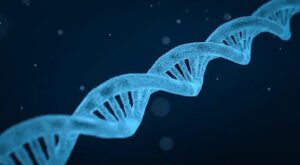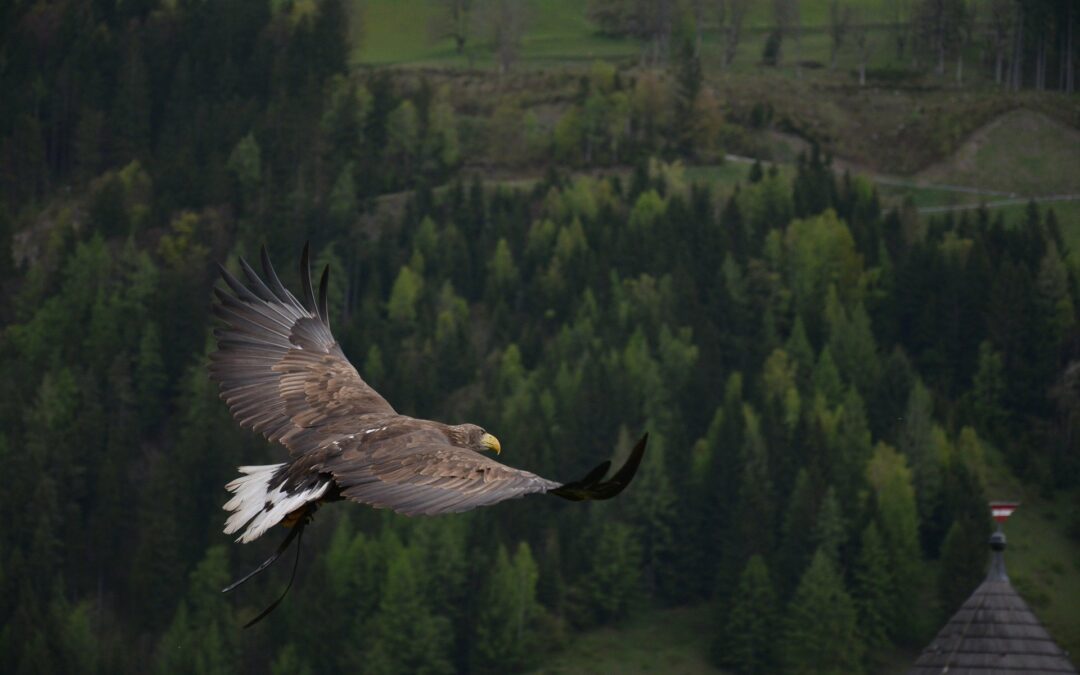Garuda is the mythical golden winged bird in Vedic literature, which is half man, half bird. Traditionally we see Garuda as an Eagle, but it can also be a large bird like a Kite. Garuda is the vehicle for Vishnu, the preserver. In Hindu mythology, Garuda has a white face, beak, golden wings and talons of an eagle or kite, and the body and limbs of a man. He is said to have stolen a pot of amrita (the nectar of immortality) to give to the serpents in exchange for them to release his stolen mother.
There are many names for Garuda, reflecting his mythological traits and features, such as Sitānana (white faced), Suvarna-kāya (golden bodied), Khageswara (king of birds), Sarpārāti (enemy of serpents), Amritāharana (stealer of amrita) and Vishnu-ratha (vehicle of Vishnu), to name a few.
In this asana, arms and legs intertwine with each other while we balance on one foot. Hands cross at the wrists, like Garuda’s wings embracing and protecting you. There are four different Hasta Mudras in this asana; sometimes the hands are pointing down and sometimes pointing up. Try to hold each hand position for about 15 seconds each.
To come into Garuda Asana, The Eagle Pose:
- Stand in Tadasana or Samasthithi. Inhale tall.
- As you exhale, transfer the weight onto the right leg. Bend the right knee slightly and cross the left leg over the right leg. Wrap the toes of the left foot behind the calf of the standing leg if possible.

- Find your balance, breathing rhythmically.
- Hold your gaze or drishti steady about 6 feet in front of the eyes.
- Now hold the arms out in front of you, and cross the right wrist over the left wrist. Place the palms together, pointing down. This is Garuda Hasta Mudra position 1. Take a few breaths here.
- Now rotate your fingertips in toward your belly and the elbows outward so that you can bring your hands up to chest level. This is Garuda Hasta Mudra position 2. Take a few breaths here.
- Keeping the palms together if possible, raise the arms up a little higher, so the hands are in front of the face. This is Garuda Hasta Mudra position 3. Take a few breaths here.
- Rotate the hands in and down toward the chest while the elbows raise, allowing you to rotate the arms and bring the hands up overhead. This is Garuda Hasta Mudra position 4. Take a few breaths here. (see video on how to move the arms).
- To come out of the pose, in reverse order, slowly move through the four Garuda Hasta mudras and unwind the arms. Then unwind the legs, returning to standing position.
- Repeat this process on the other side.
Physical Benefits
Notably this posture requires great concentration to be stable and still with the legs, yet moving with the arms. Physically this pose gives a great rotation in the shoulders, wrists and elbows as the arms move from pointing down at the pelvis, rotating upward to the chest, raising further to the face and overhead. Hand extending down at the pelvis simulate the glands lining the inside of the legs and the pelvic cavity. Hands at the mid-chest stimulate the chest glands. Hands at the face stimulate the neck and facial glands, and hands and arms overhead stimulate the exocrine glands under the arms, in the breasts, the pituitary and pineal glands within the brain.
This posture helps with lymphatic drainage in the groin, breasts, throat and under the armpits. Many cancerous disorders may arise from congestion in these areas, so this pose creates that pressure and release for lymphatic drainage, becoming a line of defense against infection in the body. Because of this glandular stimulation, we can classify this asana also as a mudra.
Garuda Asana will help to relieve stiff muscles. We balance as we stretch up, creating an isometric pull. It gives a superb long stretch of the spinal column while standing. It has been found to be helpful with low back pain resulting from slipped or herniated discs. It also counters any overstretching that can occur in postures such as the seated forward bend (Paschimottanasana).
More Subtle Benefits
If we really want to reap the benefits of an asana, then we need to embody the pose for all it’s meaning and worth. In this asana we consciously bind (tension) and unwind (relax). This “squeeze and release” flushes and cleanses throughout the body. This binding also restrains the animal nature within us (represented by the lower limbs) so the higher mind can then dictate (represented by the upper limbs).
Eagles have the benefit of “eagle eye view” by seeing the big picture from above with keen observation, beyond the perspective of our tiny selves. In this steadiness we can expand our perspective of life’s situations and consciously take in the full perspective.
The arms and legs are like braided electrical cables, representing strength and flexibility. Braided cables shield from magnetic influences so when we are intertwined like this we shield ourselves from other influences. Energetically we are intertwining the Ida and Pingala nadis around the Sushumna, bringing balance to the left and right sides, or all the opposites for that matter. This balance and harmony is imperative for spiritual growth. Vines grow in circular motions, spiralling upwards, also representing our personal growth.

Garuda Asana even resembles the caduceus, the staff of Hermes intertwined by two serpents, and two wings at the top! It is like the two lotus petals at the ajña chakra, with the bindu between the brows. Hermes is the Greek god representing superhuman or Olympian strength, stamina, and agility, and the ability to move easily between Heaven and Earth. The caduceus is traditionally associated with healing and is often seen as a logo representing Health Care. (Caduceus image Gordon Johnson pixabay free license).
Garuda Asana is truly a healing asana, harmonising the energies of the physical and the subtle body, binding it all together so the spiritual kundalini energy can flow. It is a raising above the physical to the spiritual.
Look at how the arms and legs intertwine, like the kundalini coiled 3.5 times and extending upward. DNA is a double helix bound. Our lower and upper limbs intertwined may magnify our own DNA structure. (DNA image quimono pixabay free license). Kundalini coils 3.5 times at the base of Brahma’s canal. Similarly, 3.5 Aº (Angstroms) is the exact measurement between repetitions of the human DNA helix. Another interesting point is that 3.5 is not that far off from 3.14, and in ancient times 3.14 could easily have been mistaken as 3.5. As we know, the mathematician’s number of PI, or 3.14, is known as the “infinite decimal” that goes on forever. It is also known as the “golden ratio” as seen in the Logarithmic spiral, which is replicated in nature everywhere. (i.e. nautilus shell, petals of flowers, water going down the drain, etc. ). Perhaps this 3.5 times around the base of the Brahmi Nadi is representative of this golden ratio and the infinity of the Self?
Another interesting point is that 3.5 is not that far off from 3.14, and in ancient times 3.14 could easily have been mistaken as 3.5. As we know, the mathematician’s number of PI, or 3.14, is known as the “infinite decimal” that goes on forever. It is also known as the “golden ratio” as seen in the Logarithmic spiral, which is replicated in nature everywhere. (i.e. nautilus shell, petals of flowers, water going down the drain, etc. ). Perhaps this 3.5 times around the base of the Brahmi Nadi is representative of this golden ratio and the infinity of the Self?
The multi layers of an asana goes deep, beyond our wildest imaginations if we take the time to self-study it. Garuda is said to hold a pot of “amrita”, the nectar of immortality… perhaps this amrita is the DNA that carries forth in our offspring, creating another layer of our infinite selves…..
WANT MORE? If you would like to enjoy more on Garuda Asana, please watch Dr. Ananda Balayogi Bhavanani’s discussion on “Scintillating Saturdays” https://www.youtube.com/watch?v=YabJ-DWI5Mo

Marion Mugs McConnell is the co-founder of SOYA and the SOYA Yoga Teacher Training program. This year she celebrates 51 years of yoga and continues to dedicate her life to this amazing path, revealing the gems of true, classical yoga.
Mugs is the author of Letters from the Yoga Masters: Teachings Revealed through Correspondence from Paramhansa Yogananda, Ramana Maharshi, Swami Sivananda, and Others, published by North Atlantic Books copyright © 2016 ISBN 978-1-62317-035-6.
Article Resources:
- Yoga Step by Step, by Dr. Swami Gitananda Giri Maharaj;
- Dr Ananda Balayogi Bhavanani’s talk on “Scintillating Saturdays” https://www.youtube.com/watch?v=YabJ-DWI5Mo ;
- Sri Kant Georges discussion and demonstration, Yoga Step by Step Lesson 29;
- Heather Thomas, SOYA 500 hr graduate YTT answer in one of her lessons on Kundalini.
- A Classical Dictionary of Hindu Mythology and Religion: Geography, History and Literature, by John Dowson. Heritage Publishers, New Delhi, 1992, page 109-110;
- Britannica, The Editors of Encyclopaedia. Garuda”. Encyclopedia Britannica, 20 Dec. 2018, https://www.britannica.com/topic/Garuda . Accessed 22 May 2021.;
- Picture sourses The Caduceus, https://classicalwisdom.com/culture/the-caduceus-magical-staff-of-hermes/#:~:text=The%20caduceus%20was%20a%20staff,his%20many%20associations%20and%20attributes.&text=Later%2C%20it%20became%20the%20symbol,the%20Greek%20god%20of%20healing ; Eagle photo copywrite free image from Pixabay.



Recent Comments